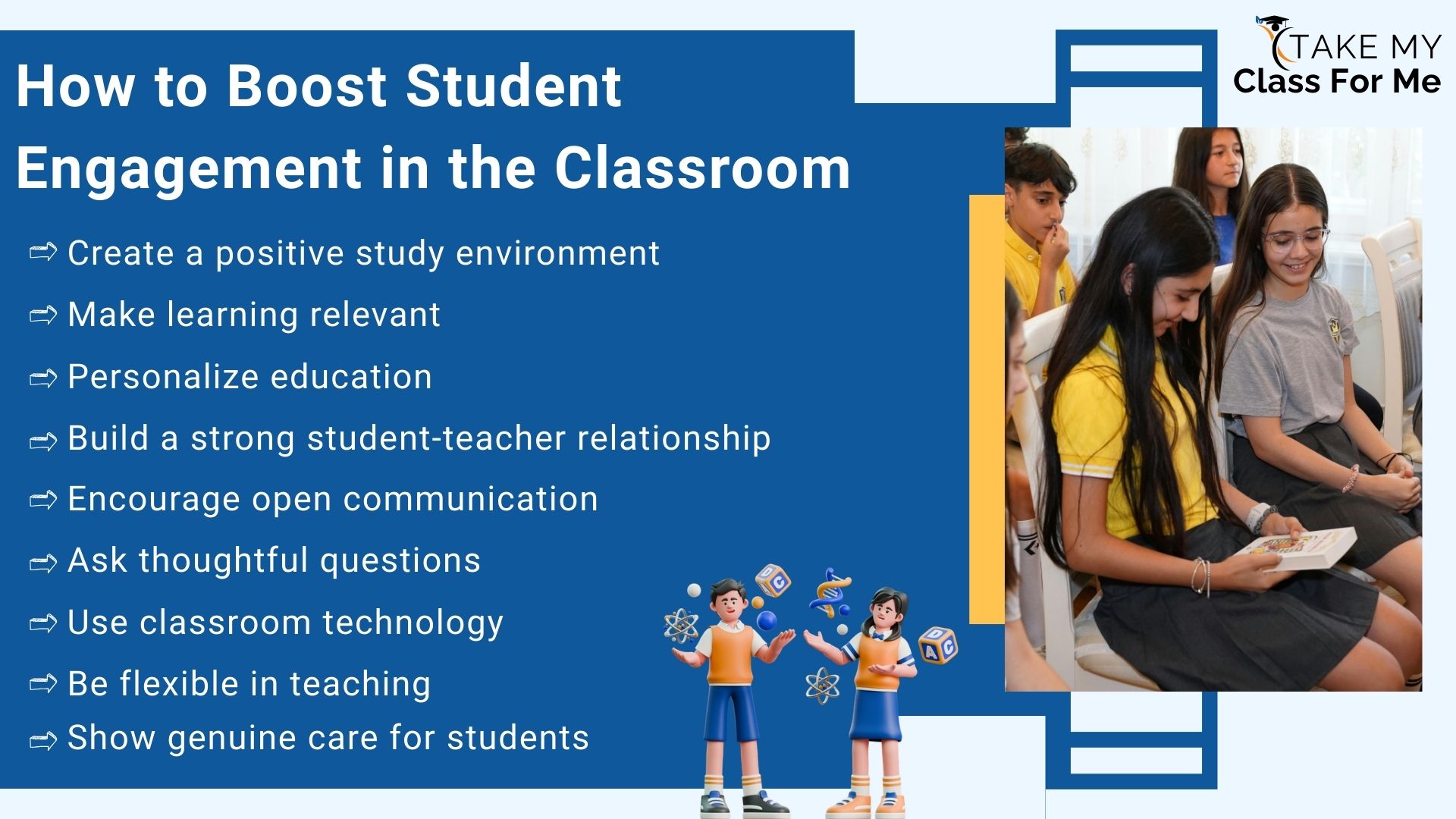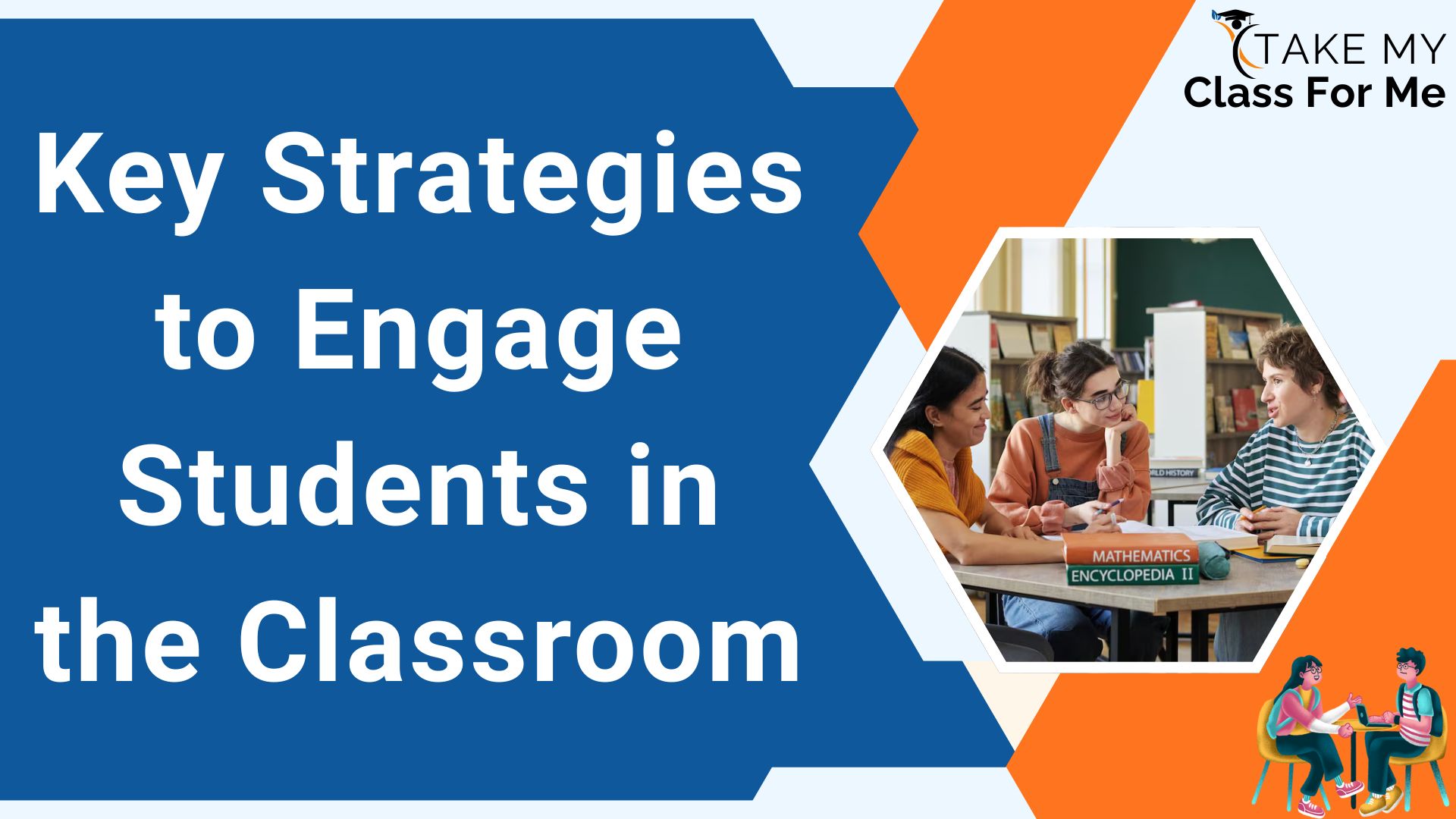Follow some key strategies to engage students in the classroom. Make sure to create a friendly learning environment and teach interactive lessons to keep students interested. Personalize learning to fit their needs. Encourage open communication so everyone feels heard. Also, use technology to make lessons more fun and easy to understand.
Schools and universities play a major role in shaping the future of students by providing them with the knowledge and skills needed for career development. However, keeping students engaged in class has always been a challenge for them. A recent survey found that only about half of the students attend classes regularly, and even fewer take part in classroom activities. So, it becomes the role of the teachers to increase student engagement in the classroom. When students are more involved in their classes, they will enjoy learning and feel more connected to their studies. This, in turn, will help students achieve better results and behave with a sense of responsibility.
If you are a teacher who is unsure how to encourage student involvement, then read this blog. Here, we have recommended some valuable strategies to engage students in the classroom. You can follow those simple and effective tips to improve student participation in classroom activities.
An Overview of Student Engagement in the Classroom
Student engagement means how actively students take part in classroom activities. It includes their involvement in designing the curriculum and joining extracurricular activities on campus. Sometimes, people confuse student engagement with student motivation. Engagement is more about how focused, curious, interested, and excited students are during class. Motivation, on the other hand, helps students to stay interested and avoid boredom while learning.
When students are engaged, it creates a better learning environment. Also, it helps improve communication between teachers and students. Many factors can encourage students to participate more in class. Teachers, school staff, and others play an important role in helping students get involved in their lessons. When engagement increases, students are more likely to attend classes regularly, finish their assignments on time, and follow instructions from their teachers.
Factors that Affect Student Involvement in the Class
A student’s engagement in the classroom is influenced by both internal and external factors. Here, let us explore the factors that play an important role in how actively a student participates in classroom activities.
Internal Factors
Internal factors are personal traits or behaviors within a student that affect how much they engage in the classroom. These factors can either increase or reduce their participation in learning. The three main internal factors are:
- Behavioral Engagement: It refers to what students do during class. It includes how they behave, how they interact with classmates, and whether they take part in class or school activities like group work or extracurricular events.
- Emotional Engagement: It looks at how students feel about school. This includes their attitude toward the subject, how they respond to teachers and peers, and whether they seem excited or interested in the class. Positive emotions help students stay involved and perform better.
- Cognitive Engagement: It focuses on how much mental effort students put into learning. It includes their interest in the subject, how deeply they try to understand the lessons, and whether they set goals for themselves. It also shows how much time and focus they give to their studies.
External Factors
Besides internal factors, outside influences also affect student participation in the classroom. These external factors come from the student’s surroundings, such as family, friends, and social background. They play a big role in shaping a student’s learning experience.
- Family support motivates students and helps them stay engaged. Students from wealthier families often have better access to learning resources, while those from low-income families may face challenges that reduce engagement.
- Peer influence how involved students feel. Positive friendships encourage participation and improve social skills.
- Sociocultural factors such as culture, family environment, and financial stress can make it harder for students to focus and take part in class.
All these factors cause students to lose interest in attending their classes. Also, this makes them feel anxious and stay away from learning. Some students even look for ways to avoid their work and search online to pay someone to do my online class. Skilled online class tutors can support students. But it is the teacher’s responsibility to encourage students to join in class, build connections, and keep them focused and engaged.
How to Boost Student Engagement in the Classroom

Student engagement plays a key role in helping learners stay focused and improve their learning experience. If you want to boost the participation of students in the classroom, then first be actively involved yourself as a teacher. Once you are engaged, you can use effective tools to make lessons more interesting. Below are some easy strategies to engage students in classroom tasks and learning.
Create a positive study environment
To improve student engagement, first create a positive and friendly classroom environment. This will help students feel comfortable, build connections with teachers and other classmates, and learn more effectively.
Make learning relevant
Some students lose interest in class when they struggle to understand the material and complete homework. So, they might look for services to take my online trigonometry class. No matter what issue the students face, as a teacher, you can fix it by connecting lessons to real-life examples. When students see how the subject relates to their daily lives, they understand better and become more interested in learning.
Personalize education
Every student is unique. So, try to use different strategies to engage them. Specifically, provide personalized learning after identifying their strengths and weaknesses. Also, make sure to regularly check their progress and discuss any concerns or ideas.
Build a strong student-teacher relationship
Generally, creating a safe and caring environment will help you boost student engagement. When you show genuine care and respect, your students will feel secure and focus better. Even small acts of kindness from you can build trust and motivate them to be more involved.
Encourage open communication
Many teachers do most of the talking, which can make students lose interest and seek online class help. So, encourage two-way communication to create an interactive study environment where your students feel comfortable sharing. Let them speak and work together to increase engagement and help shy students overcome challenges.
Ask thoughtful questions
Open-ended questions help students learn better. So, instead of asking questions that can be answered with yes or no, ask questions that make students explain their thoughts. Usually, guessing questions will also help students explore ideas and understand the topic more deeply.
Use classroom technology
Technology can improve your teaching and boost student learning. Moreover, it will help you keep your students engaged, personalize lessons, and build important future skills. Simply, by using educational apps and games, you can make learning fun and prepare student for a tech-driven world that keeps their interest high.
Be flexible in teaching
As a teacher, you should use various teaching methods to motivate students and boost their participation. Generally, responsive teaching will focus on your students’ needs, interests, and learning styles, while giving helpful feedback to support their academic progress.
Show genuine care for students
Showing care for your students can boost their confidence and motivate them to learn. When students feel loved and supported, they are more likely to take part in class and do better. Make sure to encourage them with kind words, recognize their efforts, listen actively, and create a supportive, judgment-free space. Also, celebrate their successes and be available to help whenever they need.
Wrapping Up
By implementing the strategies suggested in this blog, you can engage students in the classroom. Beyond teaching, you can also use educational tools to keep students motivated and involved. If you are a student who wishes to get guidance from tutors outside, then send us a ‘Take My Online Class for Me’ request. As per your needs, the qualified professionals from our team will offer customized online class help so you can strengthen your knowledge and achieve top grades.





